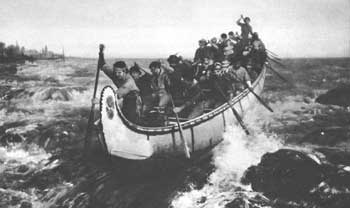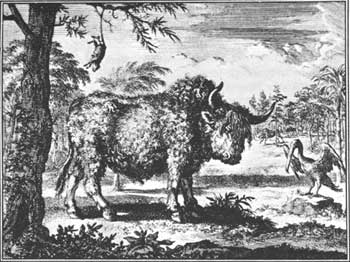






Historical Background
The French: Trappers and Traders (continued)
EXTENSION OF FRENCH INFLUENCE
In the mid-17th century, the French possessions lay on a chain of waterways extending from the great river system of the St. Lawrence, through the Great Lakes, and down the Mississippi Valley to the Gulf of Mexico. French claims to this vast region were announced by explorations such as La Salle's; and they were affirmed by the establishment of forts and small settlements, the extension of the fur trade and missionary efforts, and the spread of influence over the Indians. After 1670, conditions were especially favorable for the development of the frontier. The French had quelled the Iroquois in 1666. To check further Indian depredations and the incursions of English trappers, they then founded a series of forts.
 |
| "Shooting the Rapids." Voyageurs used the Montreal canoe, illustrated here, which was larger than the North canoe, on the Great Lakes. From a painting by Mrs. Edward Hopkins. (Courtesy, Public Archives of Canada.) |
Jesuits and trappers spread out into the western country. In 1668, at a well known and strategic location on the straits between Lake Superior and Lake Huron, Père Marquette had established a mission to the Chippewas. There, in 1671, the French held a grand council with the Indians of the region, and over the years a village called Sault Ste. Marie arose. An equally strategic point was the Mackinac Straits, a few miles to the south of Sault Ste. Marie, between Lakes Michigan and Huron. In 1670#151;71, missionaries founded St. Ignace Mission on Mackinac Island, and 2 years later relocated it at the tip of the peninsula on the north side of the straits, where soldiers built a small fort to protect the missionaries. Later, during the period 1715#151;20, the French erected Fort Michilimackinac on the southern shores of the straits. The straits area and Sault Ste. Marie were centers of missionary, as well as fur-trading, activity. From these and other bases, French missionaries penetrated the hinterland and carried the word of God to the Sioux, Chippewas, Illinois, Fox, and other tribes. The missionaries established small outlying stations, impermanently occupied for visitations.
Meanwhile, the fur trade expanded into the western country. Along the upper Mississippi, traders founded a number of posts, some of them temporary. Among the most prominent were Fort St. Croix (1680), near the portage to western Lake Superior; La Baye (1684), at the southern tip of Green Bay; Fort St. Antoine (1685), on the Mississippi between the St. Croix and Wisconsin Rivers; and Fort St. Nicolas (ca. 1685), at the mouth of the Wisconsin River, around which arose the settlement of Prairie du Chien. Troops occasionally occupied these posts, but they were primarily used as bases by the coureurs de bois—dare-devil French men who took to the forest to trade with the Indians.
The passage between Lakes Huron and Erie was the last of the connecting links in the chain of the Great Lakes that the French fortified. In 1686, they erected a small post, Fort St. Joseph, north of Lake St. Clair near the entrance to Lake Huron. Then, in 1701, Antoine de la Mothe Cadillac built Fort Pontchartrain at the southern entrance to Lake St. Clair. This fort proved to be the most important and durable of those along the Great Lakes, and around it grew up the village of Detroit. The two forts protected the water route through Lakes Ontario and Erie. Previously, most of the traffic from Montreal had passed up the Ottawa River, over the portage at Nipissing, into Georgian Bay, on the northeast of Lake Huron, and then through Lake Huron to Sault Ste. Marie and Lake Superior or to the Mackinac Straits and Lake Michigan.
 |
| "The Buffalo." From an engraving in a book by Pere Louis Hennepin, published late in the 17th century. (Courtesy, Chicago Historical Society.) |
The growing popularity of the route through Lake Erie resulted in the opening of the Wabash portage late in the 17th century to facilitate travel to the Illinois country. To protect the route, about 1704 the French founded Fort Miami at the western end of the Maumee River; in 1719, Fort Ouiatenon, on the Wabash; and, in 1735, Fort Vincennes, also on the Wabash. Besides the Wabash River route, two other earlier portage routes, which had been used by La Salle, led into the Illinois country from southern Lake Michigan. One of these was by way of the St. Joseph River, which flows into eastern Lake Michigan, to the Kankakee River, in present Indiana; the other was via the Chicago portage to the Des Plaines and Illinois Rivers. Forts Miami, St. Joseph, and St. Louis protected these two routes.
From construction in 1683 to abandonment in 1691, Fort St. Louis was an important center of French influence in the Illinois country. Subsequent posts in the region were Cahokia, near present East St. Louis, founded in 1698; at Kaskaskia, a few miles down the Mississippi, in 1703; and at St. Denis, just above the Mississippi-Ohio juncture, in 1702. These villages, conveniently situated in a fertile area between the Great Lakes and the Mississippi Delta, were a source of agricultural produce for other settlements.
 |
 |
http://www.cr.nps.gov/history/online_books/explorers-settlers/intro13.htm
Last Updated: 22-Mar-2005